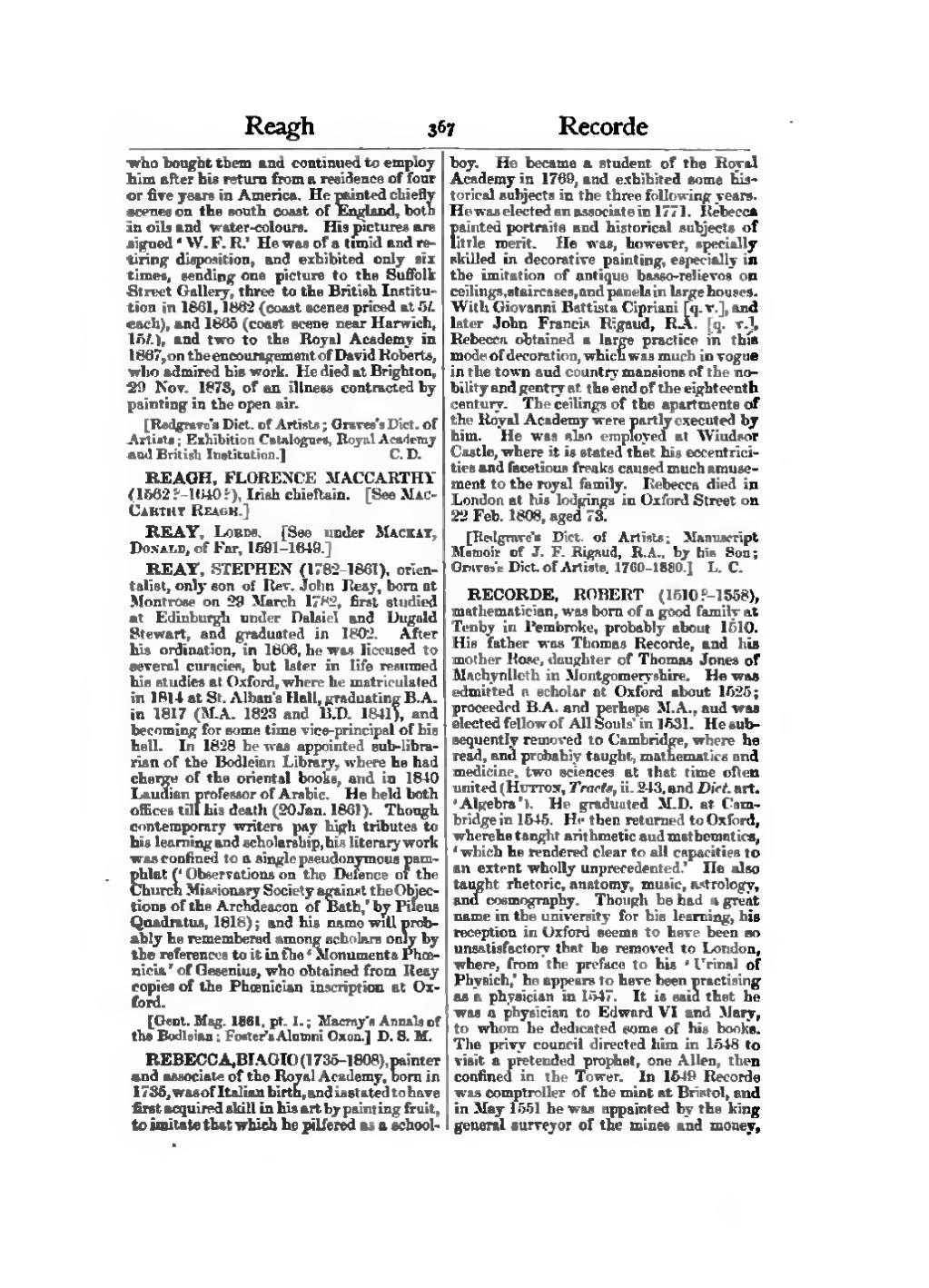who bought them and continued to employ him after his return from a residence of four or five years in America. He painted chiefly scenes on the south coast of England, both in oils and water-colours. His pictures are signed ‘W. F. R.’ He was of a timid and retiring disposition, and exhibited only six times, sending one picture to the Suffolk Street Gallery, three to the British Institution in 1861, 1862 (coast scenes priced at 5l. each), and 1865 (coast scene near Harwich, 15l.), and two to the Royal Academy in 1867, on the encouragement of David Roberts, who admired his work. He died at Brighton, 29 Nov. 1873, of an illness contracted by painting in the open air.
[Redgrave's Dict. of Artists; Graves's Dict. of Artists; Exhibition Catalogues, Royal Academy and British Institution.]
REAGH, FLORENCE MACCARTHY (1562?–1640?), Irish chieftain. [See MacCarthy Reagh.]
REAY, Lords. [See under Mackay, Donald, of Far, 1591–1649.]
REAY, STEPHEN (1782–1861), orientalist, only son of Rev. John Reay, born at Montrose on 29 March 1782, first studied at Edinburgh under Dalziel and Dugald Stewart, and graduated in 1802. After his ordination, in 1806, he was licensed to several curacies, but later in life resumed his studies at Oxford, where he matriculated in 1814 at St. Alban's Hall, graduating B.A. in 1817 (M.A. 1823 and B.D. 1841), and becoming for some time vice-principal of his hall. In 1828 he was appointed sub-librarian of the Bodleian Library, where he had charge of the oriental books, and in 1840 Laudian professor of Arabic. He held both offices till his death (20 Jan. 1861). Though contemporary writers pay high tributes to his learning and scholarship, his literary work was confined to a single pseudonymous pamphlet (‘Observations on the Defence of the Church Missionary Society against the Objections of the Archdeacon of Bath,’ by Pileus Quadratus, 1818); and his name will probably be remembered among scholars only by the references to it in the ‘Monumenta Phœnicia’ of Gesenius, who obtained from Reay copies of the Phœnician inscription at Oxford.
[Gent. Mag. 1861, pt. 1.; Macray's Annals of the Bodleian; Foster's Alumni Oxon.]
REBECCA, BIAGIO (1735–1808), painter and associate of the Royal Academy, born in 1735, was of Italian birth, and is stated to have first acquired skill in his art by painting fruit, to imitate that which he pilfered as a schoolboy. He became a student of the Royal Academy in 1769, and exhibited some historical subjects in the three following years. He was elected an associate in 1771. Rebecca painted portraits and historical subjects of little merit. He was, however, specially skilled in decorative painting, especially in the imitation of antique basso-relievos on ceilings, staircases, and panels in large houses. With Giovanni Battista Cipriani [q. v.], and later John Francis Rigaud, R.A. [q. v.], Rebecca obtained a large practice in this mode of decoration, which was much in vogue in the town and country mansions of the nobility and gentry at the end of the eighteenth century. The ceilings of the apartments of the Royal Academy were partly executed by him. He was also employed at Windsor Castle, where it is stated that his eccentricities and facetious freaks caused much amusement to the royal family. Rebecca died in London at his lodgings in Oxford Street on 22 Feb. 1808, aged 73.
[Redgrave's Dict. of Artists; Manuscript Memoir of J. F. Rigaud, R.A., by his Son; Graves's Dict. of Artists, 1760–1880.]
RECORDE, ROBERT (1510?–1558), mathematician, was born of a good family at Tenby in Pembroke, probably about 1510. His father was Thomas Recorde, and his mother Rose, daughter of Thomas Jones of Machynlleth in Montgomeryshire. He was admitted a scholar at Oxford about 1525; proceeded B.A. and perhaps M.A., and was elected fellow of All Souls' in 1531. He subsequently removed to Cambridge, where he read, and probably taught, mathematics and medicine, two sciences at that time often united (Hutton, Tracts, ii. 243, and Dict. art. ‘Algebra’). He graduated M.D. at Cambridge in 1545. He then returned to Oxford, where he taught arithmetic and mathematics, ‘which he rendered clear to all capacities to an extent wholly unprecedented.’ He also taught rhetoric, anatomy, music, astrology, and cosmography. Though he had a great name in the university for his learning, his reception in Oxford seems to have been so unsatisfactory that he removed to London, where, from the preface to his ‘Urinal of Physick,’ he appears to have been practising as a physician in 1547. It is said that he was a physician to Edward VI and Mary, to whom he dedicated some of his books. The privy council directed him in 1548 to visit a pretended prophet, one Allen, then confined in the Tower. In 1549 Recorde was comptroller of the mint at Bristol, and in May 1551 he was appointed by the king general surveyor of the mines and money,
